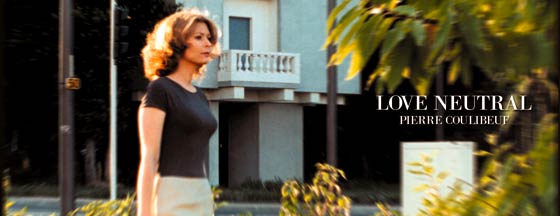
Pierre Coulibeuf Opening hours: Wed - Sat, 2 - 7 p.m. |
ARTIST’S STATEMENT :
- The installations (still and moving images)
« Lost Paradise » and « Love Neutral » are part of a cross-disciplinary project which brings together various artistic disciplines : cinema, photography, sculpture, architecture, literature and painting.
These installations are both drawn from my films « Lost Paradise » and « Love Neutral », inspired by the worlds of visual-artist photographers, namely Jean-Marc Bustamante and Suzanne Lafont. The first installation deals primarily with an artwork by J.-M. Bustamante (the sculpture-structure La Maison Close, situated in the public space), the second deals with subjects pertaining to the work of S. Lafont (portrait and landscape). These artists’ worlds are transformed by a vision, materialised here in installations composed of still and moving images. There is a transition to another imaginary universe. The relation between the works displayed in the exhibition and those of J.-M. Bustamante, S. Lafont and, of course, those of the writer Maurice Blanchot, brings to my mind a verse by Mallarmé : « I appear to myself in you like a far-off shadow. » (Herodiade). The still image gives rise to movement and in turn, the moving image generates still images which simulate the conventions of visual-artistic photography. The photographs are printed directly from the negatives of the original film, more precisely from the rushes (doubles of edited scenes), and are presented as small “photographic paintings”. Between these two traditional categories, the exhibition presents projections of “cinematic paintings”, frozen scenes which push back the frontiers, in this case of artistic categories: the still photographic image, and the moving cinematic image overlay one another in such a way that the limits between them become indiscernible. Subject (portrait/close-up or landscape), fixedness (photo/shot with characters or landscapes), and length (photo/unique shot) are put into a relationship of reciprocal tension.
The installation « Who’s who ? » consists of three videos: « Who’s Marina Abramovic », «Who’s Michelangelo Pistoletto ? » and « Who’s Meg Stuart ? », respectively from « Balkan Baroque », « L’Homme noir » and « Somewhere in between », all films of mine. This installation plays segments from the original films within two visual contexts: video and - for « Who´s Marina Abramovic ? » - photography : the fixedness of the camera, its frontal position in relation the subject and the décor, the reference to video-performance art, the close-up and the narrative effect, all bring out the multiplicity of relationships between cinema and these two visual objects. The presentation of photos (in the form of “photographic paintings”) printed directly from the original film fulfils the photographic potentialities of the film, above and beyond that which we call in cinema “the photography of film”. In addition, the spatial disposition of objects (videos and photos) should bring into play a vertiginous, and oscillatory relationship between the still and the moving image, and so show the spectator the interval, the in between-images, where the Unknown is fleetingly revealed.
- The concepts
« Lost Paradise »
Man’s fall from paradise marks the beginning of a space of dislocation, the fractured space of multiple, changing locations, tending towards singularity. The dislocation of space leads to the questioning of the limits of place. Man, left to his own devices, is disorientated within his own off-centre, relativised universe, indifferent to his presence. He is indecisive, fickle, the plaything of chance and encounters. A melancholic feeling accompanies the scant reality of the world, and its silent, enigmatic presence. « Lost Paradise » makes reference to this distance between Man and the world, this state of ill-defined melancholy provoked by a desire for infinity, for the abolition of limits - desire doomed to remain forever unsatisfied.
« Love Neutral »
A circular and off-centre construction, with an underlying principle of repetition-variation encompassing all of its audiovisual components. This movement displaces little by little the rules of representation. Figures, rather than characters. The figure is this form which draws near to and liberates itself from the notion of the character, which reduces presence to a borderline state, which destroys representation. The figure as nothing more than appearance, a mental projection. Faces, as strange apparitions, detached from the décor. Faces, as landscapes, are the realm of sensation. Voices, like separated spirits, are liberated from all psychological expression. « Love Neutral » : proposing of a world which is not the representation of reality, but rather its reflection.
« Who’s who ? » :
1. «Who’s Marina Abramovic?», 2. «Who’s Michelangelo Pistoletto?», 3. «Who’s Meg Stuart?»
About the idea of “portrait”: the constantly evolving subject, fluctuations of identity, metamorphosis, the dissolution of the self ; the space between images: a shift from the social image, the status of the artist, to imaginary images. The question of representation: images as simulacra: interpretations: pure inventions. Cross-disciplinarity: the ambiguity or uncertainty of identities, but also of artistic codes. Inventing a place “on the frontier”: between the language of cinema and the language of video.
At the opening, the new book by Pierre Coulibeuf published by
fine arts unternehmen books
and Ambassade de France, Bureau du Cinéma, Bureau des Arts Plastiques, AFAA,
will be officially presented.